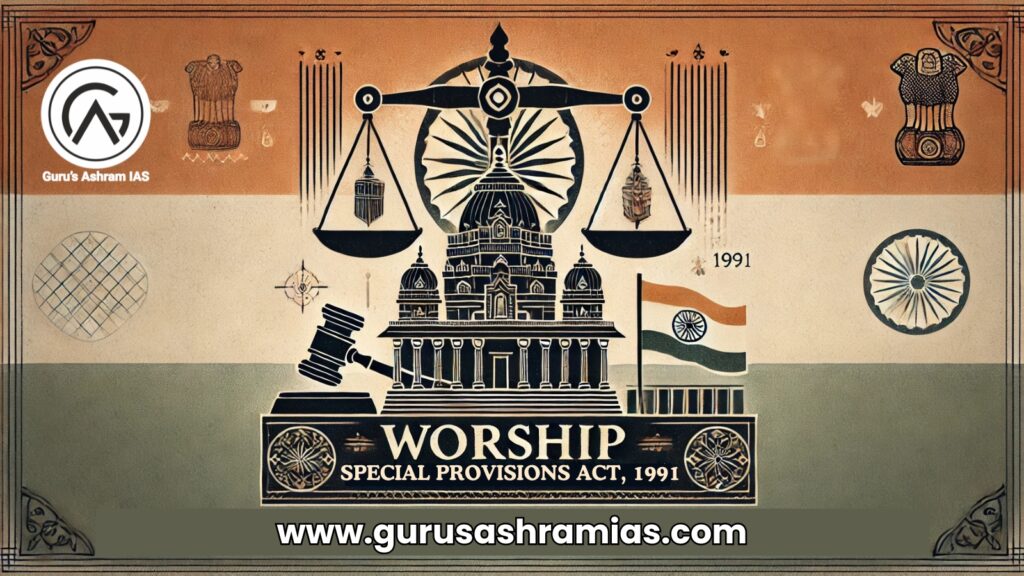Worship (Special Provisions) Act, 1991
- The Places of Worship (Special Provisions) Act, 1991, which preserves the religious character of places of worship, remains controversial amid ongoing legal challenges.
- The Shahi Jama Masjid controversy in Sambhal, Uttar Pradesh has reignited the debate on the applicability of the Act.
Shahi Jama Masjid controversy:
Background of the dispute:
- The petitioners claim that the 16th century Jama Masjid in Sambhal was built on the site of an ancient Harihar Mandir (Hindu temple).
- Built around the year 1528 by Mir Hindu Baig, a general under the Mughal emperor Babur, the mosque has distinctive stone masonry with domes and arches, unlike other Mughal mosques built of red sandstone.
- Due to its history and architecture its relationship is speculated to be like earlier structures, including a possible Hindu temple.
- This is like similar disputes that took place in Varanasi, Mathura and Dhar. The petitioners have sought a survey to determine the historical and religious character of the site.
Judicial Involvement:
- Sambhal District Court ordered a peaceful survey to verify the claims. However, the second survey also resulted in violent clashes.
Legal status of the mosque:
- Shahi Jama Masjid is a protected monument under the Ancient Monuments Preservation Act, 1904. It is listed as a monument of national importance by the Archaeological Survey of India (ASI).
Shahi Jama Masjid and Places of Worship Act, 1991:
- The Places of Worship (Special Provisions) Act, 1991 is at the centre of this controversy.
- The Act provides that the religious character of places of worship, as they existed on 15 August 1947, should be protected and prohibits any change in the religious identity of such places.
- The provisions of the Act have been challenged by seeking to change the religious character of the mosque in the Shahi Jama Masjid dispute.
The Places of Worship (Special Provisions) Act, 1991:
- The purpose of the Places of Worship (Special Provisions) Act, 1991 is to preserve the religious status of places of worship and to prevent conversion between different religious denominations or within the same denomination.
- The purpose of this Act is to maintain communal harmony by keeping the religious character of these places stable and preventing disputes arising out of such conversions.
Key provisions of the Act:
Section 3:
- Section 3 of the Act prohibits conversion of any place of worship, wholly or in part, from one religious denomination to another.
Section 4 (1):
- Section 4 (1) mandates that the religious identity of a place of worship should remain unchanged from the position as on 15 August 1947. Any attempt to change the religious character is prohibited.
Section 4 (2):
- The Bill abolishes all ongoing legal proceedings relating to alteration of religious character of a place of worship before 15th August 1947 and prohibits initiation of new cases challenging the religious status of such places.
Section 5 (Exception):
- Ayodhya dispute (Babri Masjid-Ram Janmabhoomi) which was exempted from the Act.
- Apart from the Ayodhya dispute, the Act also exempts the following: Any place of worship which is an ancient and historical monument, or an archaeological site covered under the Ancient Monuments and Archaeological Sites and Remains Act, 1958.
- Cases that have already been settled or settled by mutual agreement.
- Conversion that took place before the enactment of the Act.
Section 6 (Punishment):
- The Act prescribes stringent punishment for violations, including imprisonment up to three years and fine for attempting to change the religious character of a place of worship.
Explanation of the Supreme Court:
- In May 2022, the Supreme Court held that an inquiry into the religious character of places of worship can be allowed, provided such an inquiry does not lead to any change in the religious character.
Concerns regarding the Places of Worship Act, 1991:
Limiting judicial review:
- The Act has been challenged for limiting judicial review and potentially weakening the role of the judiciary in resolving disputes.
Retrospectively scheduled date:
- The Act’s retroactively fixed date of 15 August 1947 has been criticised as irrational, likely to infringe the rights of certain religious communities.
Legal Challenges:
- Several petitions have been filed against the Act, with petitioners arguing that it prevents Hindus, Jains, Buddhists and Sikhs from reclaiming places of worship which they believe were “invaded” or “encroached” upon by historical rulers.
Exemption in respect of certain disputes:
- The exemption of the Ram Janmabhoomi-Babri Masjid case from this Act has raised concerns about the possibility of selective legal treatment of certain disputes with inconsistency.
The rise of communal tensions:
- Legal and social debates relating to the Act sometimes deal with wider communal issues.
- Critics argue that challenging the Act is likely to increase communal tensions (especially in the context of sensitive sites such as mosques, temples and churches).
Impact on secularism:
- The Act was intended to protect the secular nature of India while maintaining religious harmony, but its critics believe that it may inadvertently allow the suppression of claims of certain religious communities over historical sites, which would harm the secular fabric of the nation.
Political and Social Implications:
- The Act is often referred to in political and religious discourse, leading to concerns that religious issues can be used to promote divisiveness or garner support for political causes.
- Some of the ongoing controversies have led to social unrest, protests over claims to a religious site, and communal tensions, reflecting deep social divisions over such issues.
Solution:
The need for legal clarity:
- With different interpretations of the provisions of the Act, there is a great need for the Supreme Court to provide clear and definite guidelines on the applicability of the Places of Worship Act.
- Preventing Overreach of Local Court: The increasing frequency of interference of local courts in sensitive religious matters calls for a thorough examination of the jurisdiction limits of the subordinate courts.
- The Supreme Court must emphasise its role in monitoring cases that may have wider social or political implications.
Don’t politicise legal matters.
- Legal challenges to religious sites should be kept free from political influence so that they are not misused for ideological or electoral purposes, ensuring the credibility of the judiciary and sanctity of religious institutions.
Focusing on Unity:
- Both political parties and civil society need to prioritise unity over division. There is a need to emphasise on the shared cultural and historical heritage that binds India together beyond religion.




